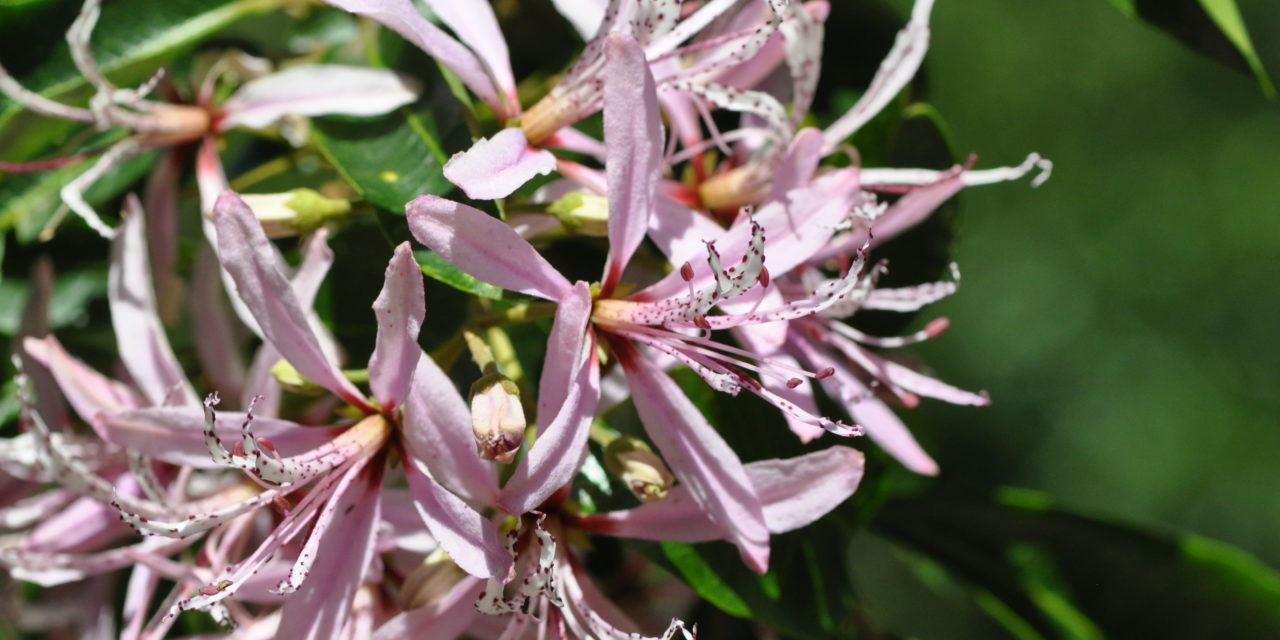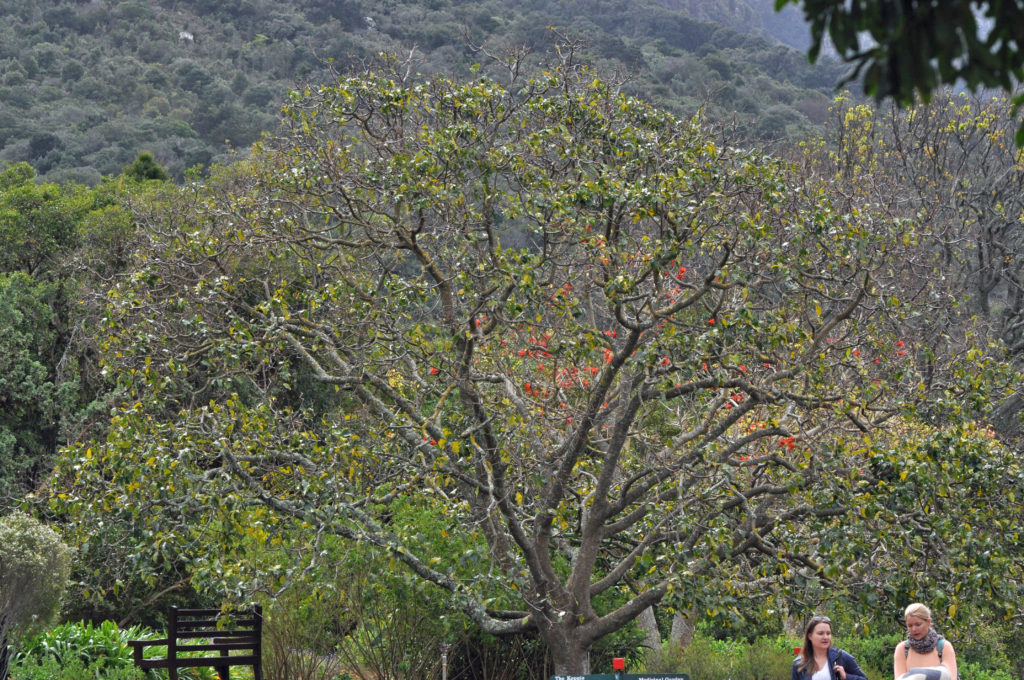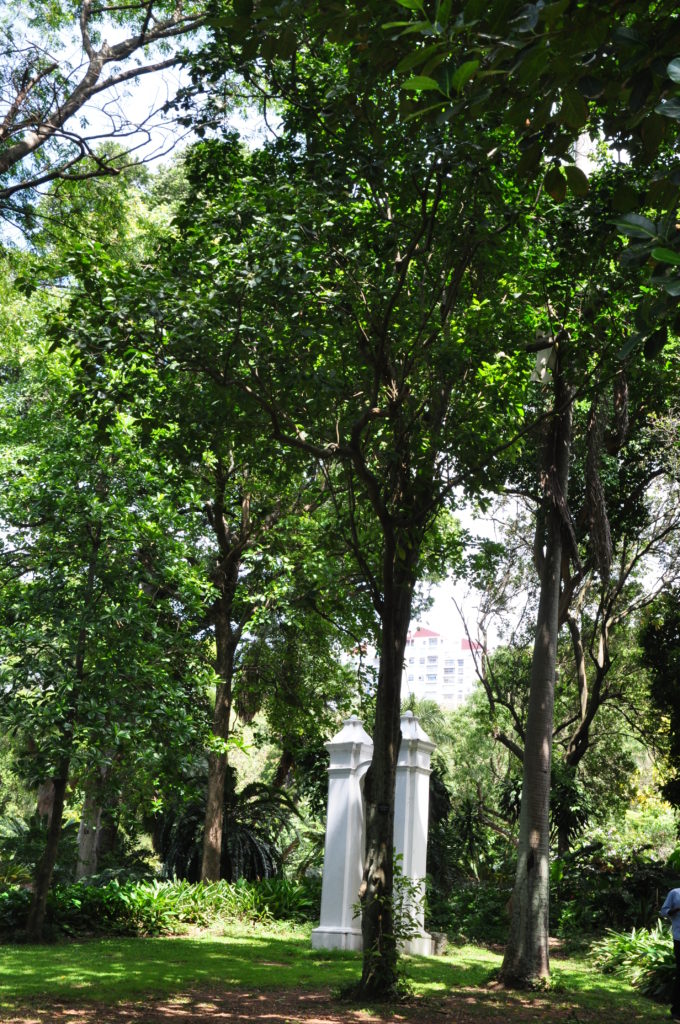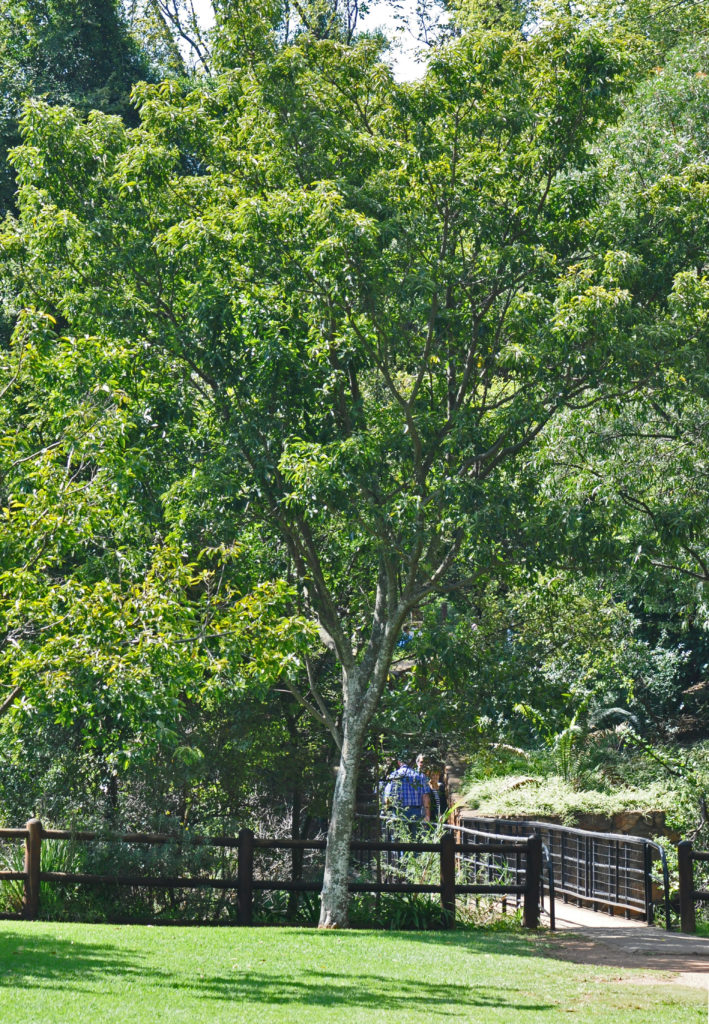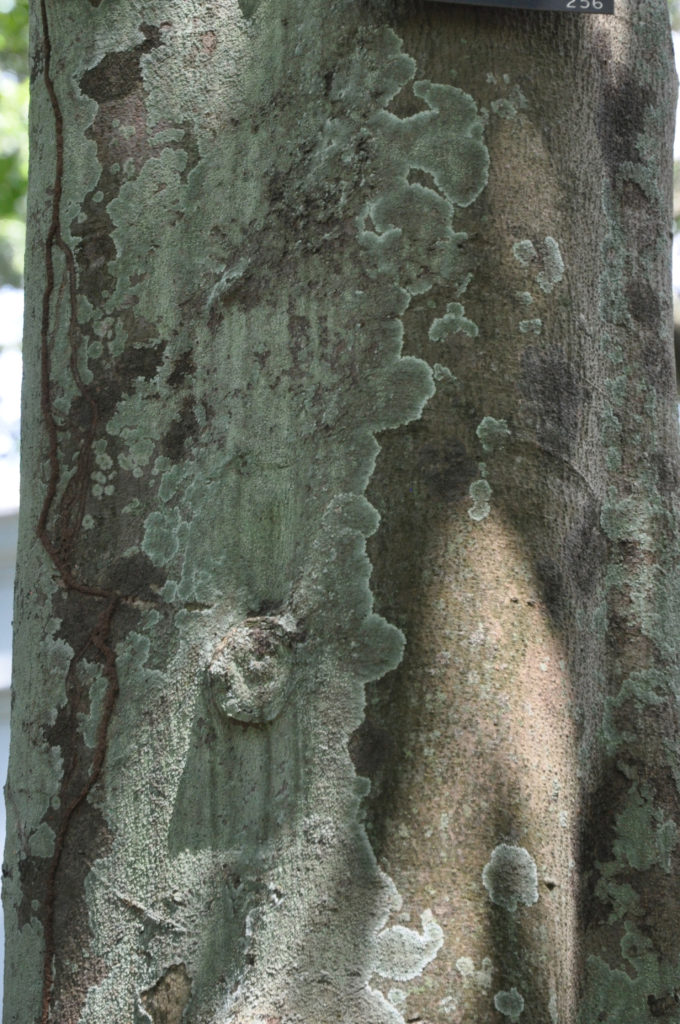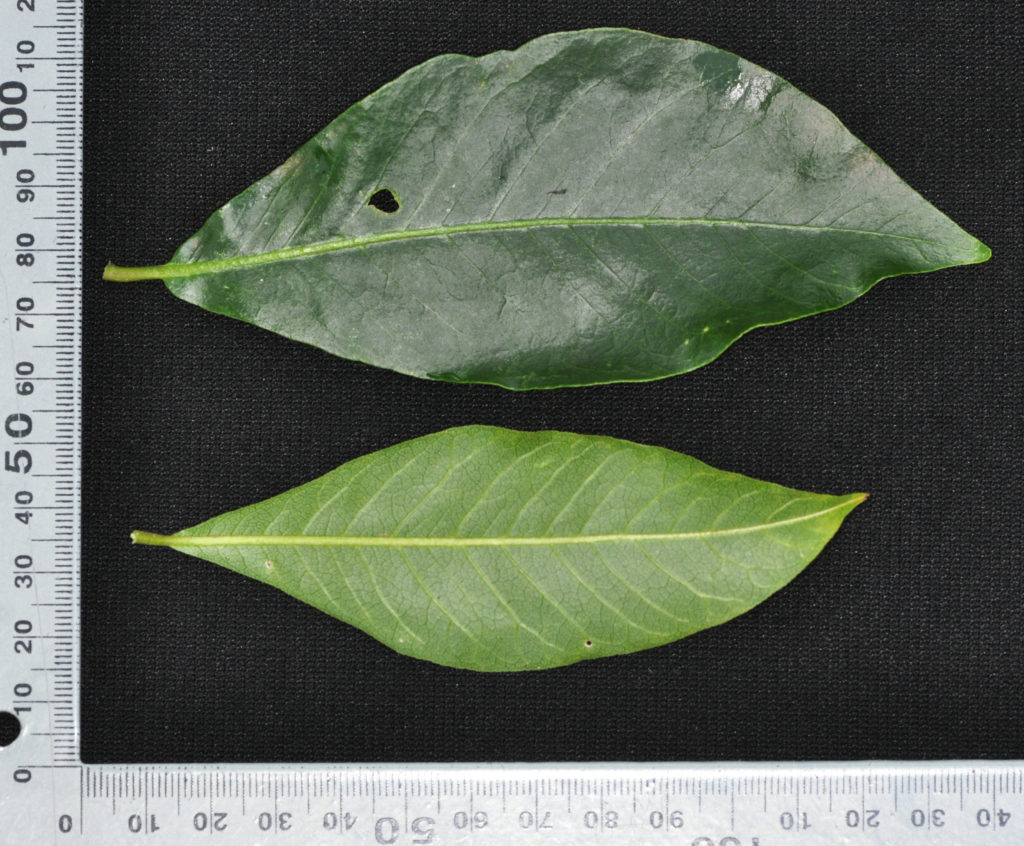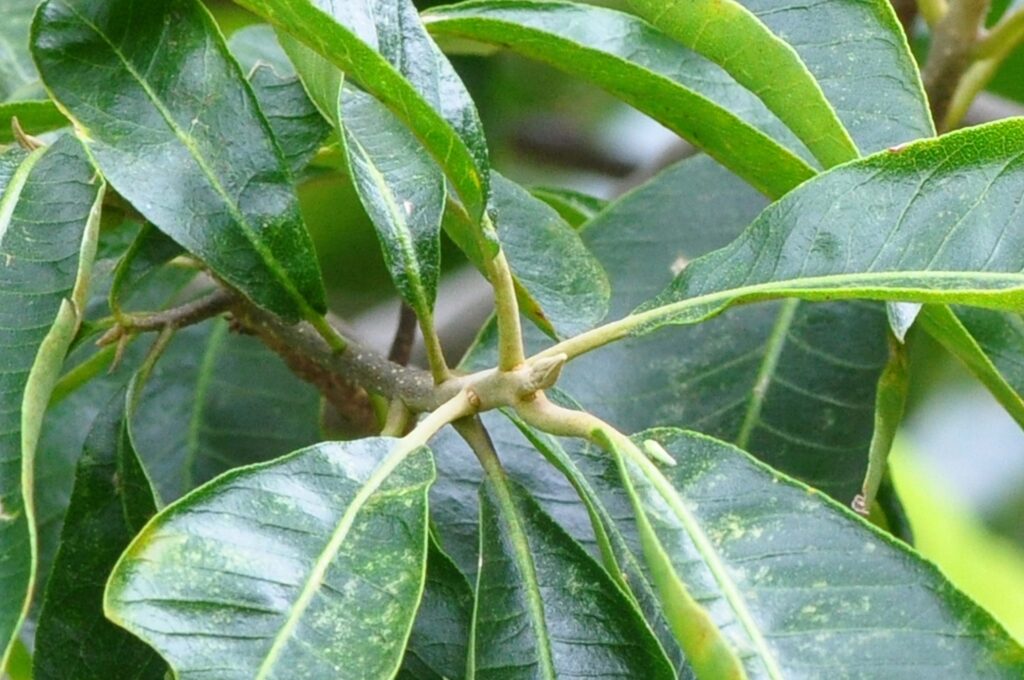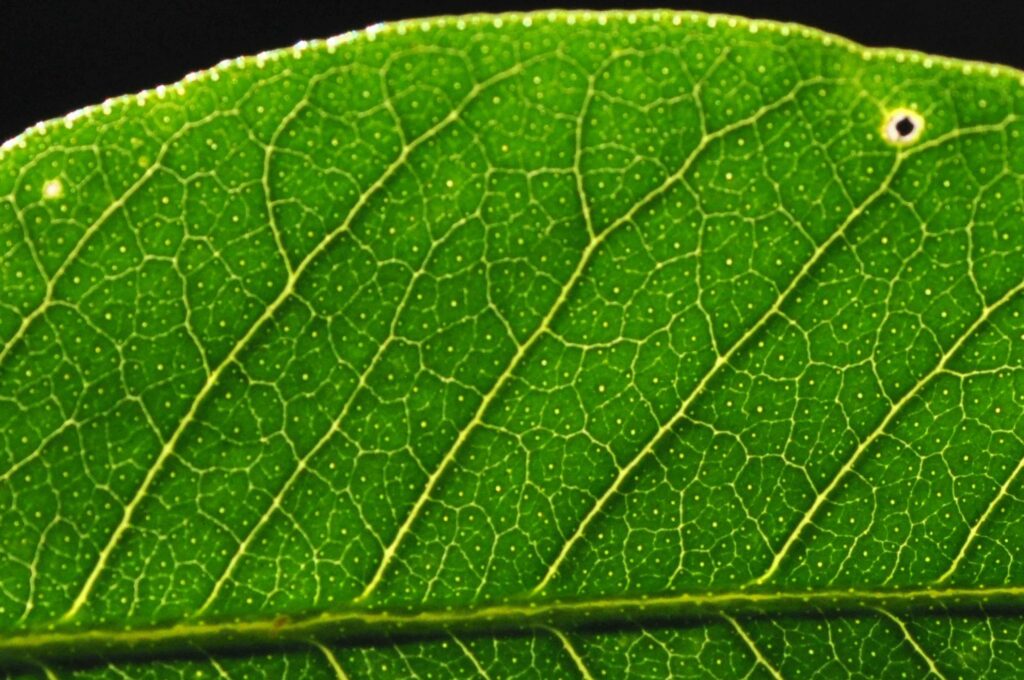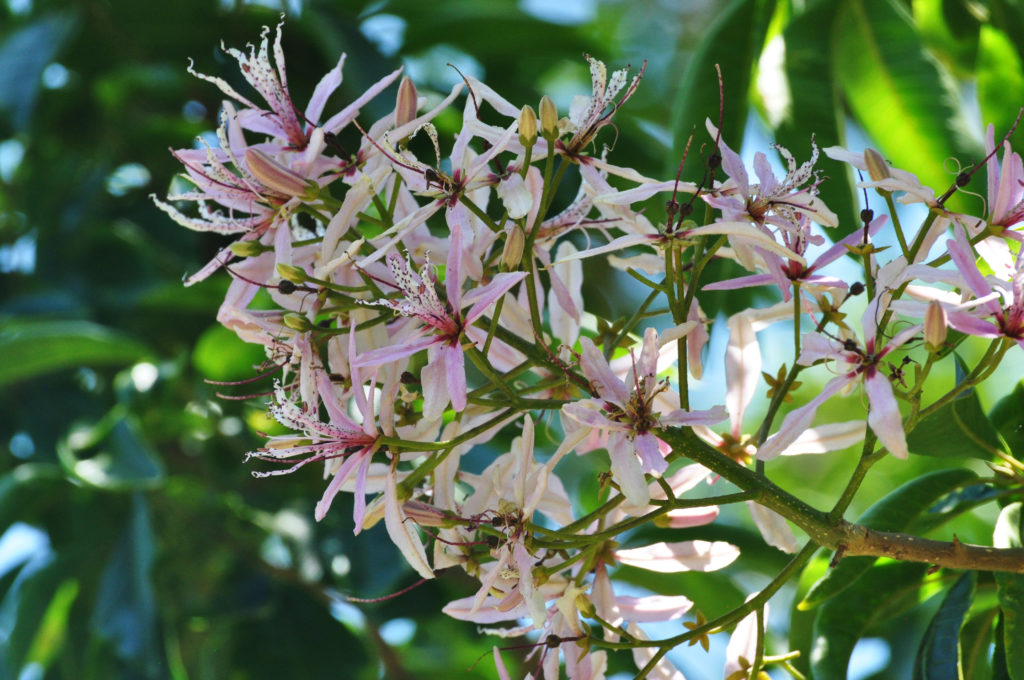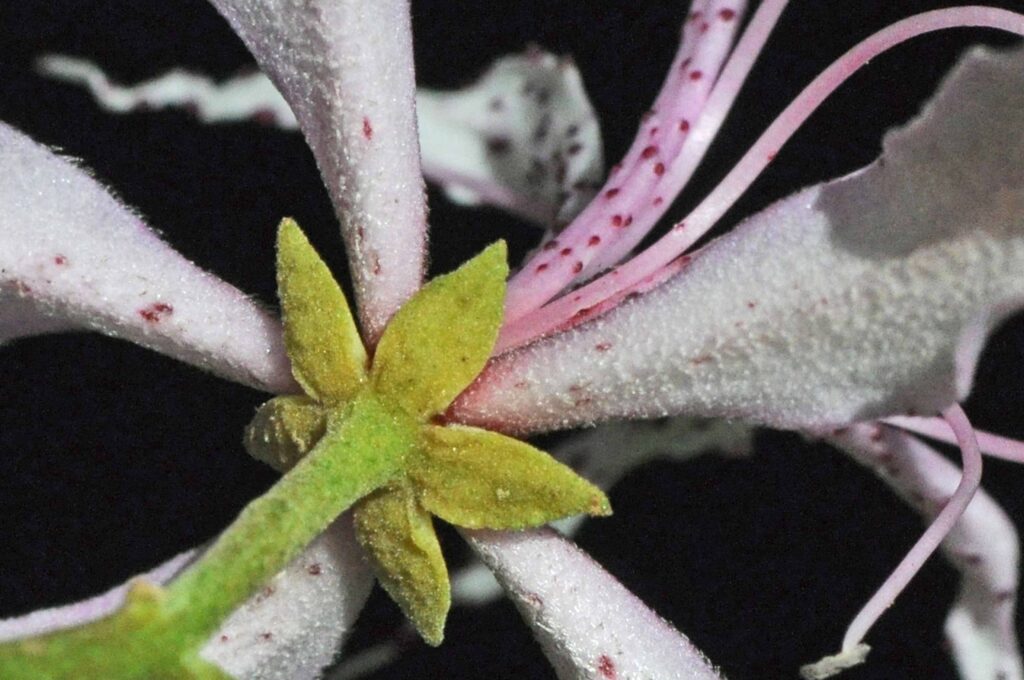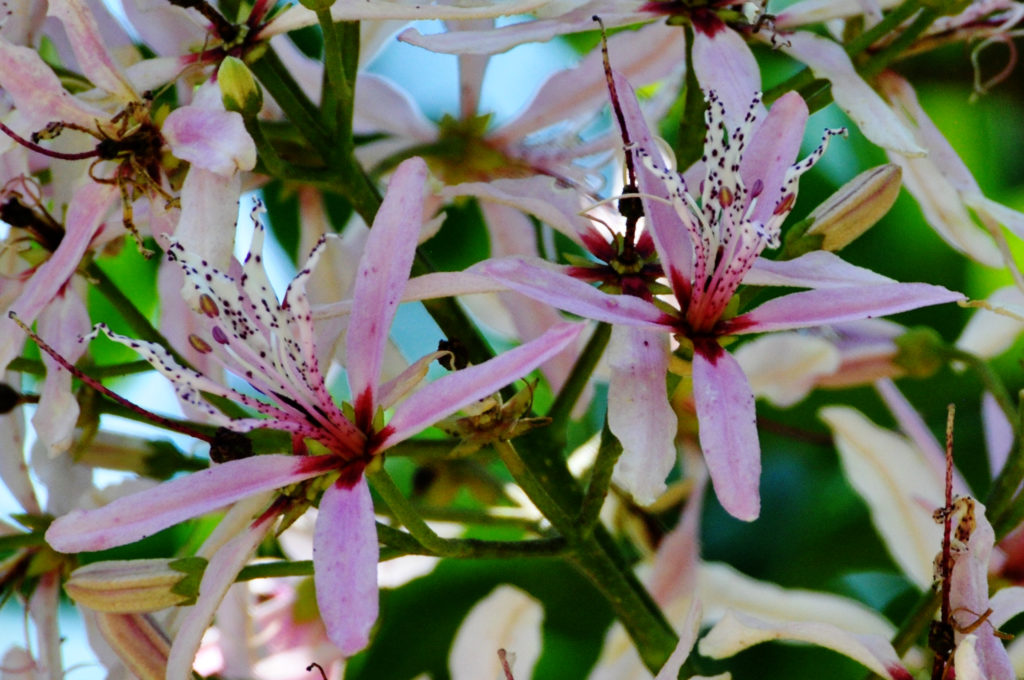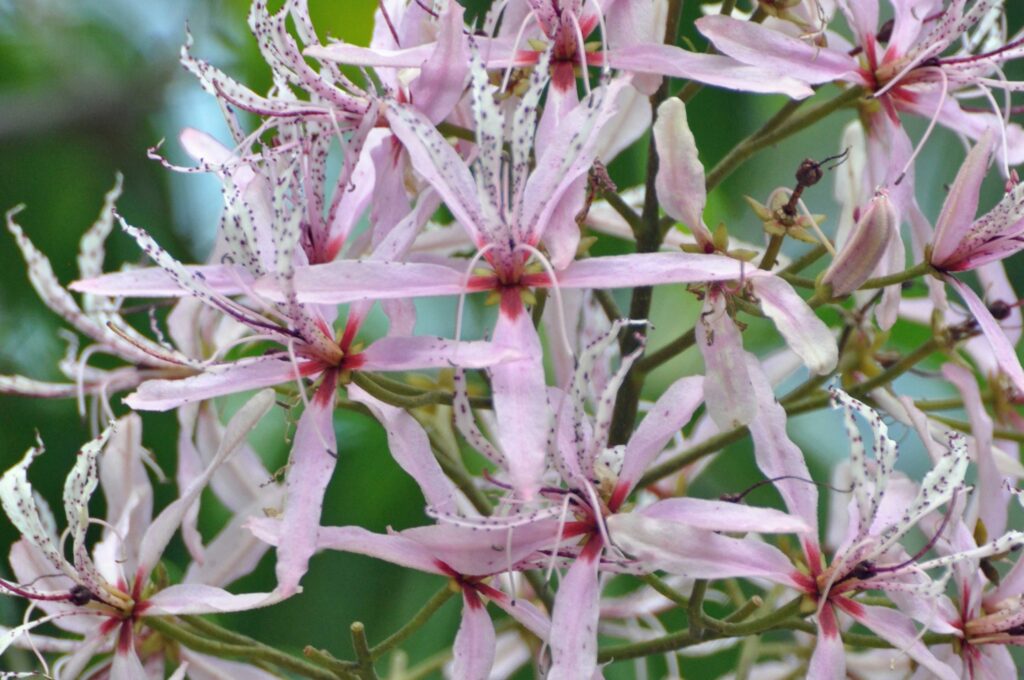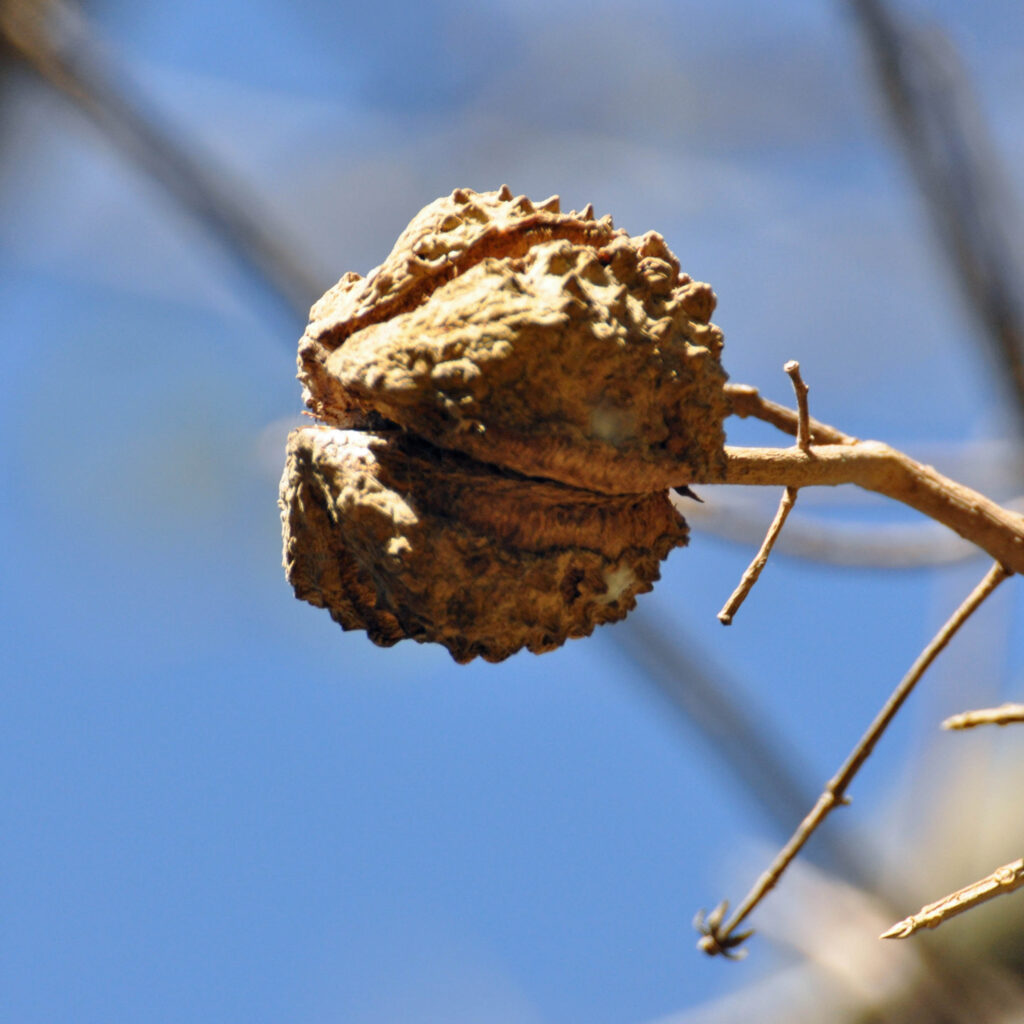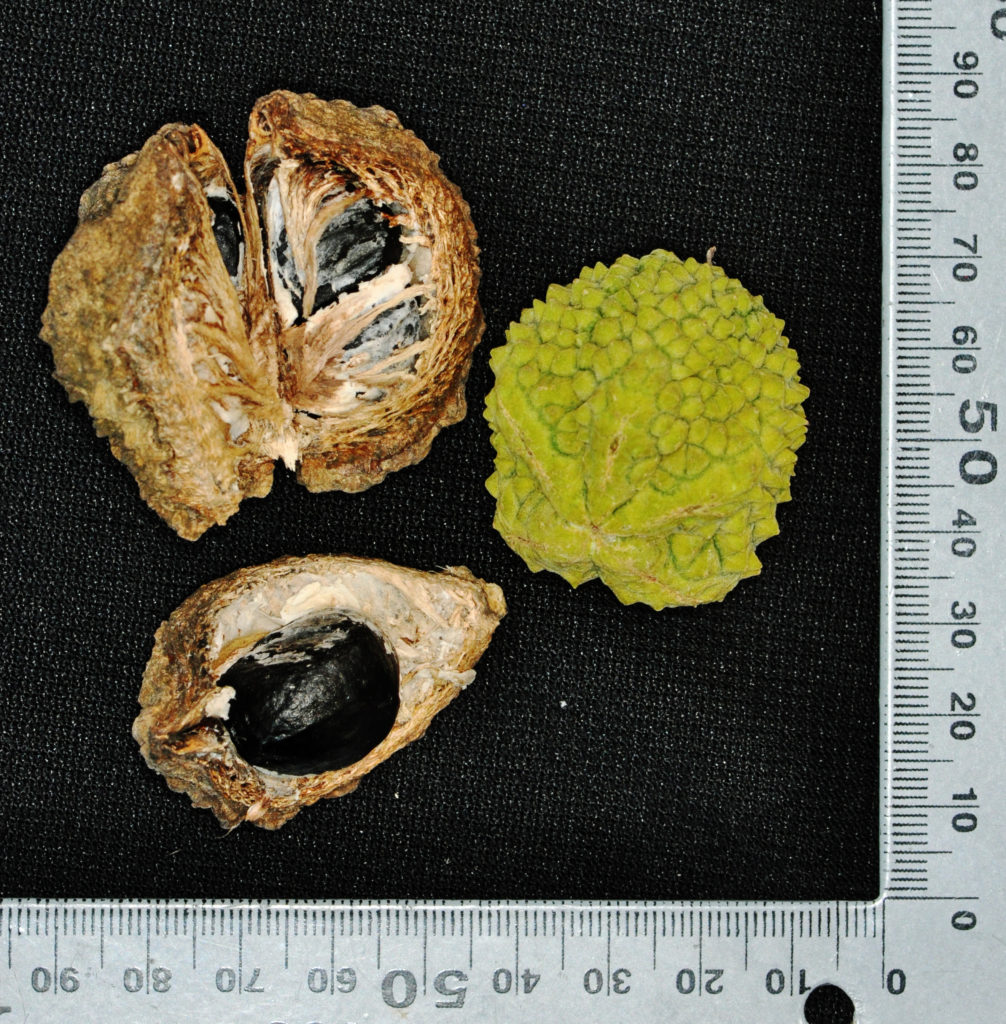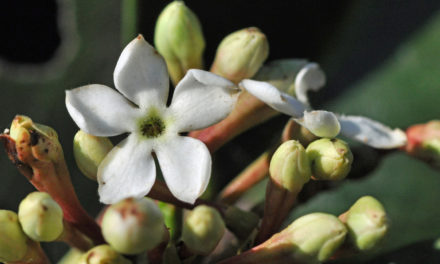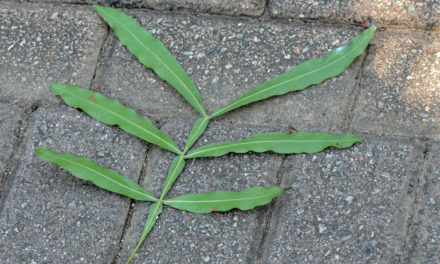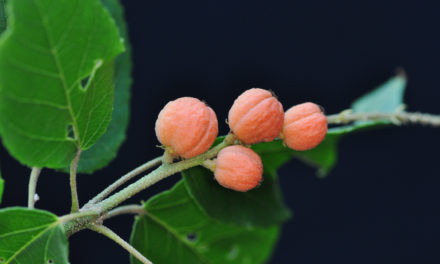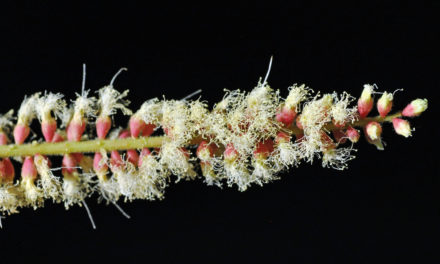Calodendrum capense
General Info – summary
This Tree with its usually smooth trunk is up to 25m high in the forest. Large simple, opposite and entire Leaves are decussate & have oil glands (translucent dots) causing crushed leaves to smell of citrus. Spectacular bisexual 5-merous Flowers with pink petals have 5 striking staminodes and anthers with pinkish filaments. The superior ovary has a gynophore. Fruit: a large woody, capsule + large dark seeds.
Description
Previous Names: Nil.
SA Tree No. 256.
Common names: (Afr) Kaapse Kastaiing, Kastaiingboom, Kastaiinghout, Kastanjehout, Wildekastaiing, Wildekastaiingboom. (Eng) Cape Chestnut, Cape-chestnut, Wild Chestnut. (isiXhosa) Umbaba, Umbatha, Umemezi, Umbhaba, Umsitshana. (isiZulu) Umbaba, Umbhaba, Umemeze Omhlophe, Umemezomhlophe. (Northern Sotho) Molalakgwedi, Mookêlêla. (siSwati) Umbhaba. (Tshivenda) Muvhaha. (Xitsonga) Mbhovha. The horse Chestnut (Castanea species: family Fagaceae) is not related to Calodendrum capense.
Family: Rutaceae. (Citrus family) has 160 genera and 2 000+ species. Leaves often have pellucid (clear, almost transparent in transmitted light) oil glands which are responsible for the aromatic smell. These gland dotted leaves are usually opposite and lack stipules. Most leaves are compound. The plants are usually monoecious. The regular Flowers are bractless, bisexual or unisexual. The 4-5 Petals are usually free. The Stamens have anthers that are dorsifixed and 2-thecous (have 2 pollen sacs). Staminodes are often present. The Ovary usually has 5 carpels, and the Style is simple. Fruit is variable. This family has 23 species in Africa. The Rutaceae in southern Africa are largely concentrated in the Western Cape. Indigenous genera with trees on this website include Calodendron, Ptaeroxylon, Vepris and Zanthoxylum. Calodendron is the only genus of this family to have large flowers.
Name derivation: Calodendrum – beautiful tree – referring to the flowers. capense – belonging to the southern Cape. This is the only indigenous species of Calodendrum in southern Africa.
Conservation: National Status: L C (Least Concern). Assessed: 2005/06/30 (W. Foden & L. Potter).
Tree
An older Tree with its straight stem, may reach 25m high in the forest and here the Bole (a single unbranched stem, the trunk) may be buttressed in taller forest trees and here branches are less spreading (photo 186). When there is less competition with surrounding trees, the tree is shorter and more spreading (photo 970). The Bark is grey and smooth (photo 623), even in old trees (photo 185). Lichen (composite organism arising from a mutualistic relationship between fungi or cyanobacteria and algae species) often grows on the trunk (lighter than the bark – photo 185). Branches are only hairy when young. Some Lenticels (usually raised corky elongated areas on the plant that allows the uncontrolled interchange of gases with the environment) are visible on the stem – below the first few pairs of leaves (photo 206 – under Leaves).
- 970. 2018/09/15. Kirstenbosch NBG. Photo: David Becking.
- 186. 2015/02/09. Durban BG. Photo: David Becking.
- 623. 2015/04/14. Walter Sisulu NBG. Photo: David Becking.
- 185. 2015/02/09 Durban BG. Photo: David Becking.
Leaves
This tree has waxy, shiny, initially hairy but finally hairless opposite Leaves that are comparatively large – up to 22 x 10cm (photo 46) and Decussate (arranged in opposite pairs – each at right angles to the next pair above or below i.e., rotated 90 degrees along the stem when viewed from above – photo 206). The tree is deciduous but can be evergreen at the coast. Even there it will lose leaves in very cold weathers. Unlike most compound leaves in the family Rutaceae, the leaves of Calodendrum capense are simple (have a single blade, which may have incisions that are not deep enough to divide the blade into leaflets). Leaves are elliptic (Oval in outline, with narrowed to rounded ends and widest near the middle – photo 46), or oblong (longer than broad with almost parallel sides). The wavy Margin contains a number of oil glands (visible as light dots – photo 47) and is entire (with a continuous margin, not in any way indented – photo 46). In this photo the Petiole (leaf stalk) is visible. It is up to 1,2cm long and Stipules (basal appendages of the petiole) are absent. The mature leaves are dark green above and a lighter green below (photo 46). Apart from the coast, leaves may turn a golden yellow before falling. The Midrib (the main rib of a leaf or leaf-like part, a continuation of the petiole) is prominent on both sides (photo 46). It is yellow below and a greenish yellow above. Many straightish side Veins point upwards towards the margin but do not quite get there (photo 47). These veins are visible on both sides but are more clearly visible below (photo 46). It is worthwhile holding a leaf against the sun to see the venation and oil glands more clearly. Here a hand lens will help (photo 47). In this photo, the many Oil glands are visible as tiny translucent yellowish dots and account for crushed leaves having a noticeable citrus aroma. The gland dots aid in plant identification. The Apex tapers or is rounded and may be acuminate (said of an acute apex whose sides are somewhat concave and taper to a protracted point – photo 46). The Base is also visible in this photo, and is cuneate (wedge-shaped; triangular with a narrow endpoint of attachment). It may be slightly lobed.
- 46. 2016/12/06. Walter Sisulu NBG. Photo: David Becking.
- 206. 2014/02/04. Walter Sisulu NBG. Photo: David Becking.
- 47. 2016/12/06. Walter Sisulu NBG. Photo: David Becking.
Flowers
These beautiful, bisexual and slightly scented Flowers develop at the ends of branches and often flower erratically. They are actinomorphic (Regular, symmetrical. Flowers are vertically divisible into similar halves by more than 1 plane passing through the axis). They are arranged in large terminal Panicles (an inflorescence in which the primary floral axis is branched, and these branches may branch repeatedly – each eventually ending in a flower – photo 957). Individual flowers are large – diameter up to 6cm. The Calyx has 5 light green Sepals that are somewhat fleshy and spread out when mature (photo 804). They protrude below, alternate with the 5 white or pale pink Petals and are imbricate (with overlapping edges). These petals are long, narrow and up to 4 x 0,5cm. The interior base of each petal is red and becomes purplish further down (photo 961). The exterior view of the petals bases is whitish (photo 804). The petals curve slightly backwards. There are 5 long relatively thin and wide petal-like Staminodes (sterile stamens) situated between, and in front of the petals. These distinctive staminodes resemble petals and are pale pink with crimson or purple gland dots (photo 961 & 804). They stand almost upright are separate from the petals and enhance the appearance of the flower (photo 961). A dome shaped Disc (a more or less fleshy or elevated development of the receptacle) is present. The 5 fertile Stamens have long, thin, pinkish Filaments (the usually long slender stalks that support the anther – photo 961). The Anthers are oblong with an immersed apical gland. There is a single Pistil (a unit of the gynoecium composed of the stigma, style and ovary). This is visible behind and to the left of the right-hand flower. Here the superior, 5 locular Ovary is supported by a long gynophore (a stalk present in some flowers that supports and may elevate the gynoecium – visible in photo 957 & 961). There are 2 ovules in each locule (cavity within an organ – in this case the ovary). The Style is much longer than the ovary. This is a special flower. Unfortunately, the flowers are often high up on a large tree and difficult to examine. (Oct-Dec. but varies and flowers may develop twice a year at the coast).
- 957. 2014/11/25. Walter Sisulu NBG. Photo: David Becking.
- 804. 2017/11/07. Walter Sisulu NBG. Photo: David Becking.
- 961. 2014/11/25. Walter Sisulu NBG. Photo: David Becking.
- 201. 2014/12/02. Walter Sisulu NBG. Photo: David Becking.
Fruit
The initially green (photo 130), becoming large, distinctive brown Fruit is a woody, 5-lobed, light brown Capsule (a dry fruit resulting from the maturing of a compound ovary, which usually opens at maturity by one or more lines of dehiscence -photo 159). This capsule, with a knobby surface is up to 4cm in diameter (photo 159) and splits into 5 lobes down the stalk from the apical end. Here lines of dehiscence are clear. The valves (separable part of a pod; the units or pieces into which the capsule splits or divides in dehiscing) remain connected to the pedicle (the stalk of a single flower – photo 159). Large shiny, oily, dark brown to black and angled Seeds are released from the fruit (photo 130). They are hard but have a low density. (Jan-May).
- 159. 2014/08/26. Walter Sisulu NBG. Photo: David Becking.
- 130. 2016/05/31. Walter Sisulu NBG. Photo: David Becking.
Distribution & Ecology
These Trees are not endemic (restricted to a particular geographic location) in South Africa. They are found in the coastal forests and riverine thickets in the Western Cape (eastwards – from close to Swellendam), Eastern Cape and inland from sea level to 2 000m e.g., Amatola mountains – to the northeast of East London and Gauteng. They also occur up the Eastern part of South Africa (coastal to tropical) in KwaZulu-Natal as well as Limpopo e.g., Willies Poort, Mpumalanga, North West. Beyond South Africa they occur in Eswatini (Swaziland), Zimbabwe, Mozambique (central e.g., Mt Gorongosa, and extreme south), Tanzania, Kenya, Uganda, Tanzania, Malawi and Ethiopia. Adult trees can withstand temperatures as low as minus 8⁰C. Several swallowtail Butterflies, like the citrus swallowtail or Christmas butterfly (Papilio demodocus) have larvae that feed on the leaves and those of other citrus trees, before pupating. Black and yellow markings as well as blue and yellow eyespots occur on these adult butterflies. Samango monkeys (occur in northern Limpopo, Mpumalanga, KwaZulu Natal and down to the Eastern Cape) consume the Seeds – as do some birds including the Rameron and Olive pigeons. The short-tailed Cape parrot (Poicephalus robustus) has a large beak and is able to break open and eat the hard blackish seeds. Its favourite fruit is from the trees of the genus Podocarpus, (a gymnosperm, but here the seeds are not in cones). Both butterflies and bees, rather than birds visit flowers and are the agents of Pollination.
Ethnobotany
These shade trees with their outstanding flowers are becoming more popular in South Africa. The Wood is tough, white or light yellow and suitable for turning. It is used for planks, furniture, shovel handles and is considered one of the most useful of our hard woods. It has a good bending capacity that is useful for making tent bows. Rather bitter lemon yellow Yangu oil is extractable by cold pressing the Seeds. The oil is used in local skin and hair care. It provides UV protection. It also has a high concentration of essential fatty acids, and is used to make soap. Good-luck bracelets are made from Seeds, and Bark is used in local cosmetics. The seeds germinate and transplant well. Cultivated trees usually grow to less than 10m high at a rate of close to 1m per year. They prefer moist soil and being frost free when young. This attractive and useful shade tree also makes a good street tree. It may take up to 8 years to flower. A worthwhile exercise is to pick and carefully examine a single impressive flower.
References
Boon, R. 2010. Pooley’s Trees of eastern South Africa. Flora and Fauna Publications Trust, Durban.
Burrows, J.E., Burrows, S.M., Lotter, M.C. & Schmidt, E. 2018. Trees and Shrubs Mozambique. Publishing Print Matters (Pty) Ltd. Noordhoek, Cape Town.
Coates Palgrave, M. 2002. Keith Coates Palgrave Trees of Southern Africa, edn 3. Struik, Cape Town.
Foden, W. & Potter, L. 2005. Calodendrum capense (L.f.) Thunb. National Assessment: Red List of South African Plants version . Accessed on 2025/01/20.
Ginn P.J. Mcilleron W.G. and Milstein P. le S, 1989. The Complete Book of Southern African Birds. Struik, Cape Town.
Lawrence, G. H. M, 1951. Taxonomy of Vascular Plants. The Macmillan Company, New York. Tenth Printing 1965.
Palmer, E. & Pitman, N. 1972. Trees of southern Africa. Balkema, Amsterdam, Cape Town.
Schmidt, S. Lotter, M. & McCleland, W. 2002. Trees and Shrubs of Mpumalanga and the Kruger National Park. Jacana, Johannesburg.
van Wyk, B. & van Wyk, P. 1997 Field guide to Trees of Southern Africa. Struik, Cape Town.
http://www.plantzafrica.com/plantcd/calodendcape.htm
https://en.wikipedia.org/wiki/Calodendrum_capense
http://www.kew.org/science-conservation/plants-fungi/calodendrum-capense-cape-chestnut
http://www.zimbabweflora.co.zw/speciesdata/species.php?species_id=133080
http://posa.sanbi.org/flora/browse.php?src=SP

